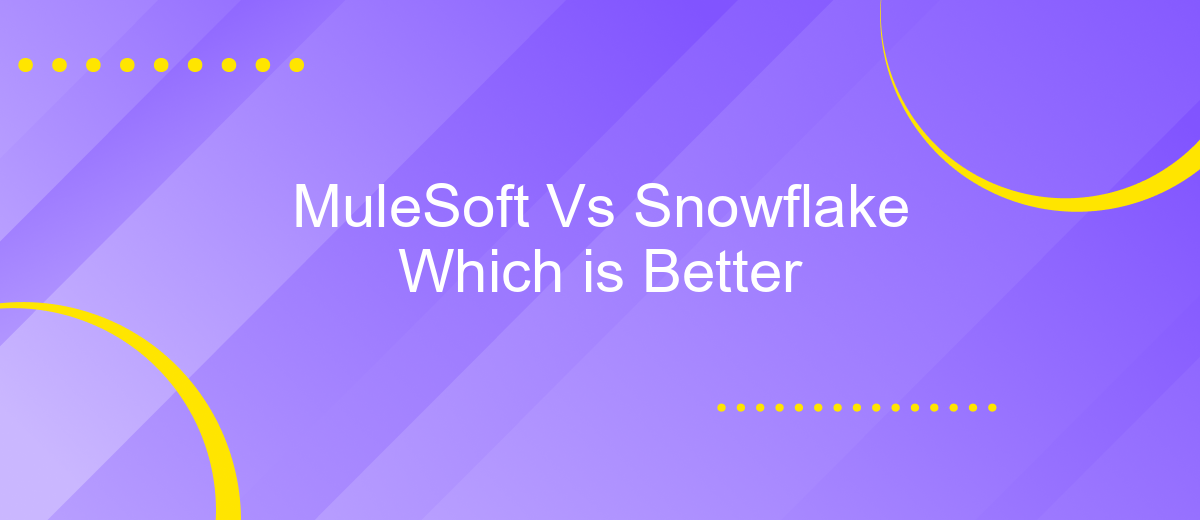MuleSoft Vs Snowflake Which is Better
In today's rapidly evolving technological landscape, choosing the right platform for data integration and management is crucial for business success. MuleSoft and Snowflake are two leading solutions that offer distinct advantages. This article delves into a comparative analysis of MuleSoft and Snowflake, exploring their features, use cases, and determining which might be the better fit for your organization's needs.
Introduction
In today's rapidly evolving digital landscape, businesses are constantly seeking efficient and scalable solutions for data management and integration. Two prominent platforms that have garnered significant attention in this domain are MuleSoft and Snowflake. Both offer unique capabilities and cater to different aspects of data handling and integration, making it crucial for organizations to understand their strengths and limitations.
- MuleSoft: Specializes in API-led connectivity, enabling seamless integration of various applications, data sources, and devices.
- Snowflake: Focuses on cloud-based data warehousing, providing a robust platform for storing, processing, and analyzing large volumes of data.
Choosing between MuleSoft and Snowflake depends on specific business needs, such as the requirement for real-time data integration or extensive data analytics capabilities. Additionally, services like ApiX-Drive can further streamline integration processes, offering automated workflows and easy-to-use interfaces. By evaluating the core functionalities and potential synergies of these platforms, businesses can make informed decisions that align with their strategic goals.
MuleSoft Overview

MuleSoft is a comprehensive integration platform that enables businesses to connect various applications, data sources, and APIs seamlessly. With its flagship product, Anypoint Platform, MuleSoft offers a unified solution for API management, design, and development, allowing organizations to streamline their digital transformation efforts. The platform supports a wide range of integration patterns, including real-time, batch, and event-driven, making it versatile for different business needs.
One of the key features of MuleSoft is its ability to facilitate complex integrations with minimal coding, thanks to its intuitive visual interface and pre-built connectors. This not only accelerates the development process but also reduces the need for specialized technical expertise. Additionally, MuleSoft's robust API management capabilities ensure secure and scalable interactions between systems. For businesses looking to further simplify their integration processes, services like ApiX-Drive can complement MuleSoft by offering easy-to-use tools for automating data transfers and workflows between various platforms.
Snowflake Overview

Snowflake is a cloud-based data warehousing solution that offers a unique architecture designed to handle diverse data workloads. Unlike traditional data warehouses, Snowflake separates compute and storage, enabling users to scale them independently. This flexibility ensures that businesses can efficiently manage their data without over-provisioning resources.
Key features of Snowflake include:
- Elastic Scaling: Automatically scales resources up or down based on workload demands.
- Secure Data Sharing: Allows seamless and secure sharing of data across organizations.
- Multi-Cloud Support: Operates on AWS, Azure, and Google Cloud, providing flexibility and redundancy.
- Advanced Analytics: Supports complex queries and integrates with various BI tools for in-depth analysis.
- Zero Maintenance: Fully managed service that handles maintenance, updates, and backups.
Snowflake's architecture and feature set make it an excellent choice for organizations looking to modernize their data infrastructure. For businesses needing to integrate Snowflake with other platforms, services like ApiX-Drive can simplify the process, offering automated workflows and seamless data synchronization across multiple applications.
Comparison of Features

When comparing MuleSoft and Snowflake, it's essential to consider their unique features and capabilities. MuleSoft is renowned for its robust integration platform, allowing businesses to connect various applications, data, and devices seamlessly. Snowflake, on the other hand, excels in data warehousing, providing a powerful platform for data storage, processing, and analytics.
MuleSoft's Anypoint Platform offers a comprehensive suite of tools for API management, design, and analytics. It enables organizations to create and manage APIs efficiently, facilitating smooth data flow across different systems. Snowflake's architecture is designed for high performance and scalability, enabling users to handle large volumes of data with ease and perform complex queries quickly.
- MuleSoft: API management, integration capabilities, real-time analytics, and design tools.
- Snowflake: Data warehousing, high performance, scalability, and advanced analytics.
For businesses looking to streamline their integration processes, services like ApiX-Drive can be beneficial. ApiX-Drive offers a user-friendly platform to automate data transfers and integrations between various applications, enhancing efficiency and reducing manual workload. In conclusion, the choice between MuleSoft and Snowflake depends on the specific needs of your business, whether it's integration capabilities or data warehousing excellence.
Conclusion
In conclusion, both MuleSoft and Snowflake offer robust solutions for businesses looking to enhance their data management and integration capabilities. MuleSoft excels in providing a comprehensive platform for API-led connectivity, making it an ideal choice for organizations seeking seamless integration across various applications and systems. On the other hand, Snowflake stands out with its powerful data warehousing capabilities, enabling businesses to efficiently store, analyze, and share vast amounts of data in a scalable and secure environment.
The choice between MuleSoft and Snowflake ultimately depends on the specific needs and goals of your organization. If your primary focus is on integrating disparate systems and APIs, MuleSoft's extensive toolkit and support for various integration patterns make it a strong contender. Conversely, if your organization requires a robust data warehousing solution with advanced analytics and data sharing features, Snowflake is the better option. For businesses needing a versatile integration service to bridge the gap between these platforms, solutions like ApiX-Drive can offer valuable assistance, streamlining the integration process and enhancing overall efficiency.
FAQ
What are the primary differences between MuleSoft and Snowflake?
Which platform is better for data integration tasks?
Can MuleSoft and Snowflake be used together?
How do MuleSoft and Snowflake handle scalability?
Are there services available to help with the implementation and integration of MuleSoft and Snowflake?
Apix-Drive is a simple and efficient system connector that will help you automate routine tasks and optimize business processes. You can save time and money, direct these resources to more important purposes. Test ApiX-Drive and make sure that this tool will relieve your employees and after 5 minutes of settings your business will start working faster.

